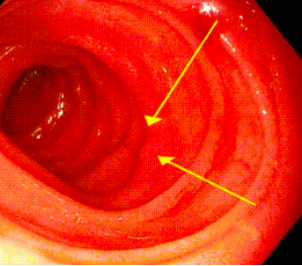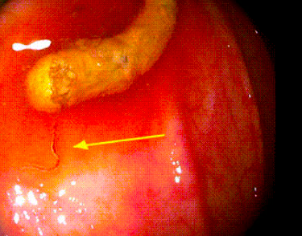Sunday Poster Session
Category: Infections and Microbiome
P1314 - Perils of Parasitism: A Novel Endoscopic Diagnosis of Severe Iron Deficiency Anemia
Sunday, October 26, 2025
3:30 PM - 7:00 PM PDT
Location: Exhibit Hall
- MK
Muhannad Kurtom, DO
UNC Health Blue Ridge
Morganton, NC
Presenting Author(s)
Muhannad Kurtom, DO, Sinclair Strange, DO, Gerald Mank, MD
UNC Health Blue Ridge, Morganton, NC
Introduction: Hookworm infections (Ancylostoma duodenale and Necator americanus) are the most common cause of iron-deficiency anemia worldwide, particularly in tropical and subtropical regions with poor sanitation, with the highest prevalence in Africa, Asia, and Latin America. Transmission occurs when larvae penetrate the skin or are ingested orally, then migrate via the bloodstream to the lungs and ultimately the intestines, where they mature. They attach to the intestinal mucosa and feed on host blood, resulting in blood loss and anemia.
Although hookworm remains prevalent in endemic regions, it is extremely rare in the United States. Diagnosis is typically made by stool testing, the gold standard for detection. In this case, endoscopy was novelly used to diagnose Ancylostoma duodenale in a patient who presented with severe iron-deficiency anemia.
Case Description/
Methods: A 29-year-old man who recently immigrated from Guatemala presented to the emergency room with a three-month history of progressively worsening weakness and lightheadedness. He denied any overt symptoms of gastrointestinal bleeding. Laboratory evaluation revealed severe microcytic anemia - hemoglobin 2.7 g/dL (normal 13.5-17.5 g/dL), MCV 51 fL (normal 80-100 fL), and marked iron deficiency - iron level of 19 μg/dL (normal 70-180 μg/dL), ferritin 2.0 ng/mL (normal 24-336 ng/mL), TIBC 409.8 μg/dL (normal 250-450 μg/dL), transferrin saturation 5% (normal 20-50%), and eosinophilia. After adequate resuscitation, esophagogastroduodenoscopy (EGD) and colonoscopy were performed. EGD revealed multiple parasitic larvae in the duodenum (Figure 1), while colonoscopy showed diffuse inflammation and shallow ulcerations throughout the colon, with additional larvae found in the cecum (Figure 2). Pathology confirmed the diagnosis of Ancylostoma duodenale. The patient was treated with a 400 mg dose of albendazole, resulting in resolution of symptoms and normalization of hemoglobin to 14.0 g/dL at a two-month follow-up visit.
Discussion: This case highlights the importance of considering hookworm infection in the differential diagnosis of iron-deficiency anemia, particularly in individuals from endemic areas. Endoscopy can be an invaluable diagnostic tool when stool testing is unavailable or is inconclusive. Recognizing endoscopic findings - such as the presence of parasitic larvae, mucosal inflammation, and ulcerations - can facilitate early diagnosis and prompt treatment, reducing morbidity from this preventable cause of anemia.

Figure: Figure 1. Ancylostoma duodenale in the duodenum

Figure: Figure 2. Ancylostoma duodenale in the cecum
Disclosures:
Muhannad Kurtom indicated no relevant financial relationships.
Sinclair Strange indicated no relevant financial relationships.
Gerald Mank indicated no relevant financial relationships.
Muhannad Kurtom, DO, Sinclair Strange, DO, Gerald Mank, MD. P1314 - Perils of Parasitism: A Novel Endoscopic Diagnosis of Severe Iron Deficiency Anemia, ACG 2025 Annual Scientific Meeting Abstracts. Phoenix, AZ: American College of Gastroenterology.
UNC Health Blue Ridge, Morganton, NC
Introduction: Hookworm infections (Ancylostoma duodenale and Necator americanus) are the most common cause of iron-deficiency anemia worldwide, particularly in tropical and subtropical regions with poor sanitation, with the highest prevalence in Africa, Asia, and Latin America. Transmission occurs when larvae penetrate the skin or are ingested orally, then migrate via the bloodstream to the lungs and ultimately the intestines, where they mature. They attach to the intestinal mucosa and feed on host blood, resulting in blood loss and anemia.
Although hookworm remains prevalent in endemic regions, it is extremely rare in the United States. Diagnosis is typically made by stool testing, the gold standard for detection. In this case, endoscopy was novelly used to diagnose Ancylostoma duodenale in a patient who presented with severe iron-deficiency anemia.
Case Description/
Methods: A 29-year-old man who recently immigrated from Guatemala presented to the emergency room with a three-month history of progressively worsening weakness and lightheadedness. He denied any overt symptoms of gastrointestinal bleeding. Laboratory evaluation revealed severe microcytic anemia - hemoglobin 2.7 g/dL (normal 13.5-17.5 g/dL), MCV 51 fL (normal 80-100 fL), and marked iron deficiency - iron level of 19 μg/dL (normal 70-180 μg/dL), ferritin 2.0 ng/mL (normal 24-336 ng/mL), TIBC 409.8 μg/dL (normal 250-450 μg/dL), transferrin saturation 5% (normal 20-50%), and eosinophilia. After adequate resuscitation, esophagogastroduodenoscopy (EGD) and colonoscopy were performed. EGD revealed multiple parasitic larvae in the duodenum (Figure 1), while colonoscopy showed diffuse inflammation and shallow ulcerations throughout the colon, with additional larvae found in the cecum (Figure 2). Pathology confirmed the diagnosis of Ancylostoma duodenale. The patient was treated with a 400 mg dose of albendazole, resulting in resolution of symptoms and normalization of hemoglobin to 14.0 g/dL at a two-month follow-up visit.
Discussion: This case highlights the importance of considering hookworm infection in the differential diagnosis of iron-deficiency anemia, particularly in individuals from endemic areas. Endoscopy can be an invaluable diagnostic tool when stool testing is unavailable or is inconclusive. Recognizing endoscopic findings - such as the presence of parasitic larvae, mucosal inflammation, and ulcerations - can facilitate early diagnosis and prompt treatment, reducing morbidity from this preventable cause of anemia.

Figure: Figure 1. Ancylostoma duodenale in the duodenum

Figure: Figure 2. Ancylostoma duodenale in the cecum
Disclosures:
Muhannad Kurtom indicated no relevant financial relationships.
Sinclair Strange indicated no relevant financial relationships.
Gerald Mank indicated no relevant financial relationships.
Muhannad Kurtom, DO, Sinclair Strange, DO, Gerald Mank, MD. P1314 - Perils of Parasitism: A Novel Endoscopic Diagnosis of Severe Iron Deficiency Anemia, ACG 2025 Annual Scientific Meeting Abstracts. Phoenix, AZ: American College of Gastroenterology.
